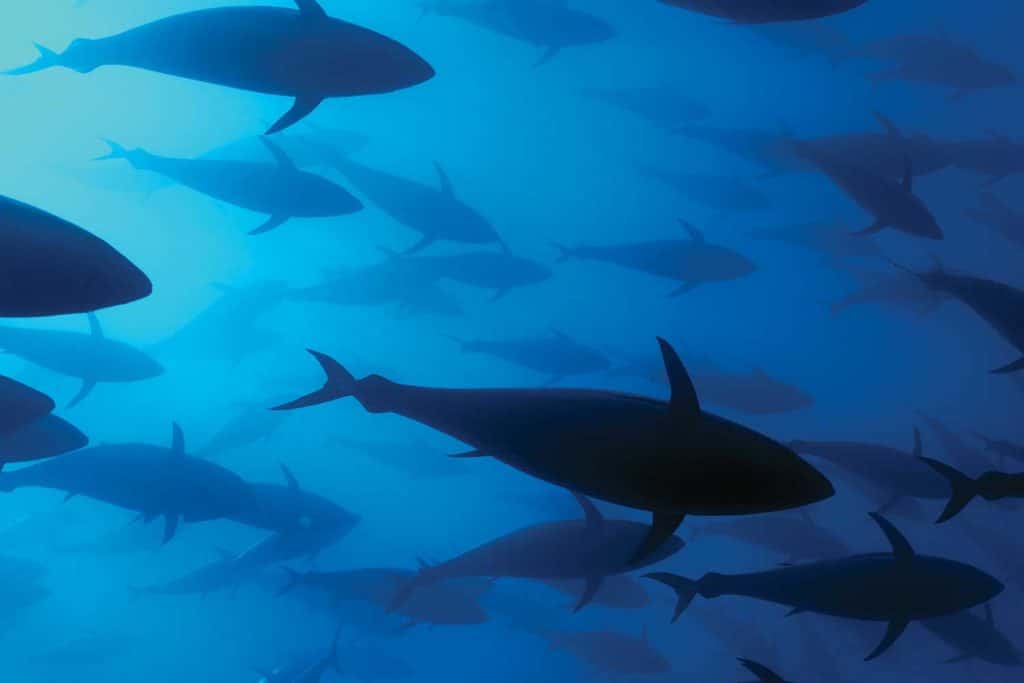
Although it doesn’t receive much publicity, catching bluefin tuna around the British Isles is nothing new. In the middle of this past century, a historically famous tuna fishery existed in the North Sea, that frigid expanse of gray water that separates the eastern coast of England from Scandinavia. Sportsmen chartered motherships to take them offshore to rendezvous with the commercial herring and mackerel fleet, where they knew they would also find large schools of bluefin, eagerly mopping up the inevitable bycatch each time a net was hauled. Lorenzo Mitchell Henry landed the heaviest fish off Scarborough, North Yorkshire, in 1933; it weighed 851 pounds.
The Rise of Industrial Fishing
Following World War II, increased mechanization and efficiency was widely introduced throughout the various European commercial-fishing fleets, which quickly resulted in the decimation of the once-vast shoals of herring, mackerel and other fish species. With the loss of their primary food source, the tuna disappeared as well. At the same time, the tuna themselves came under increasing commercial pressure throughout much of their range, most notably in the Mediterranean Sea, which remains a major spawning region for the eastern Atlantic population of bluefin tuna.
But since 2000, the numbers of bluefin tuna being seen and caught throughout the Mediterranean, along with numerous locations elsewhere within their traditional range across northern Europe, have been steadily, if not rapidly, increasing. Mature tuna are being reported off the coasts of Norway, Sweden and Denmark, while throughout much of the Mediterranean in late summer, the numbers of immature bluefin tuna are so large, they can actually become a nuisance when trying to target other species.
Watch: Learn to rig a swimming Spanish mackerel here.
Surprising Resurgence
There are several reasons why fisheries biologists think numbers of bluefin tuna are currently increasing. The various conservation measures in place throughout the main breeding areas for bluefin in the Mediterranean are being enforced and are starting to pay dividends. The species has also benefited from a run of successful breeding seasons in ideal conditions, resulting in high numbers of juveniles and boosting existing stocks.
The third reason attributed to the resurgence of bluefin tuna is somewhat surprising: the fall of Col. Moammar Gadhafi in Libya in 2011. Gadhafi’s son, Saif al-Islam, once operated a bluefin tuna ranch at Shabiat Elmergeb in northeast Libya, along with four huge tonnaras, which are tuna nets that keep the fish alive until they are ready for sale. These were located in the Gulf of Sidra, which is a spawning ground for bluefin tuna as well as a marine sanctuary.
Prior to Col. Gadhafi’s demise, Libya operated a fleet of at least 48 purse seiners, which resulted in a hefty percentage of the entire Mediterranean bluefin tuna production being caught in Libyan waters. He was accountable to no one; tuna stocks were open to massive exploitation. Available figures show that approximately 12,000 metric tons of bluefin tuna were once harvested annually off the coast of Libya, but that was only what was declared to ICCAT. It is almost certain that a far greater quantity was caught each year.
The Med on the Mend
Bill François, a researcher in biophysics and a volunteer helping to coordinate French bluefin tuna tagging programs with the Monaco Game Fishing Federation, says: “The spectacular return of bluefin tuna in the Med after decades of severe overfishing is still a big mystery, but there are several possible explanations. Commercial fishermen often quote the drastic decrease of catch limits as one of the main reasons. This has certainly helped but was not enough; the scientific models show the quotas on industrial fishing would not have allowed a recovery of the fish stocks. The end of the Gadhafi regime, which organized most of the illegal poaching of spawning tuna, has led to a big decrease in overfishing.
“Finally, natural reasons also might have had some impact,” François continues. “Bluefin tuna have been caught in the Mediterranean since prehistoric times. Over these 2,000 years of catch reports, they have noticed some cycles of abundance with a period of about 30 years, and other longer ones lasting about a century. These cycles might be linked to prey-abundance dynamics, and to solar-activity patterns. Today the bluefin fishery in the Mediterranean is incredible, and each year we observe more fish very close to shore; some have even been caught from the rocks.”
Read Next: Costa Rica’s hypocrisy toward dolphin is appalling. Read more here.
Off Limits in the United Kingdom
All of this is great news for anglers fishing in almost all of the European countries where bluefin are found, including Spain, France, Italy, Malta, Morocco and Croatia, because these countries have an allocated quota maintained for the recreational sport-fishing industry. However, specifically targeting bluefin tuna in both the United Kingdom and Ireland—either commercially or recreationally—is illegal because neither country has an allocated quota for the species. As you can imagine, this is incredibly frustrating. Each year tuna are caught, usually by accident by anglers drifting baits intended for sharks. Fish estimated to weigh well over 700 pounds have been released in the UK, and the Irish record bluefin tuna weighed in at 968 pounds and was caught by Adrian Molloy on October 5, 2001.
In 2019, a few sport-fishing boats that met a specific list of requirements stipulated by the team of scientists running a program called Thunnus UK were allowed to actually target tuna for the first time. Experienced anglers who had previously applied for a permit by confirming their experience handling big fish were allowed to book a trip aboard participating volunteer boats in order to aid in the capture of bluefin for electronic-tagging purposes.
Bluefin tuna captured by volunteers were transferred to a central tagging vessel, where they were measured, tagged and released. In the first four weeks of the 2019 season, a total of 17 bluefin tuna were tagged with MiniPAT (pop-up) satellite tags. A similar project was run off the west coast of Ireland, again using only previously registered sport-fishing boats. We hope that the data gathered will help to eventually establish a recreational sport-fishing industry for bluefin tuna in the UK. Given the numbers of fish we now see each summer, it should be one hell of a fishery.







